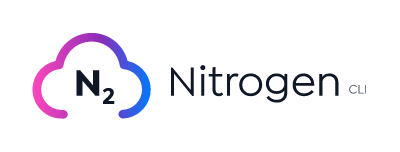6 releases
| 0.2.5 | Dec 8, 2022 |
|---|---|
| 0.2.4 | Nov 15, 2022 |
| 0.1.0 |
|
#418 in Hardware support
43KB
1K
SLoC

Nitrogen CLI
Nitrogen is a tool for deploying web services to AWS Nitro Enclaves. Given a dockerfile and an ssh key, Nitrogen will spin up an EC2, configure the network, and build and deploy your web service. You get back a hostname that's ready to go. Nitrogen is fully open source and it comes with pre-built scripts for deploying popular services like Nginx, Redis, and MongoDB.
Install
Nitrogen can easily be installed with the following:
For Linux or Mac:
$ curl -fsSL https://raw.githubusercontent.com/capeprivacy/nitrogen/main/install.sh | sh
For Windows Powershell
$ iex (irm https://raw.githubusercontent.com/capeprivacy/nitrogen/main/install.ps1)
Note: An AWS account is required. If you have AWS cli configured you can retrieve your credentials with cat ~/.aws/credentials. See troubleshooting if your AWS account uses MFA
export AWS_ACCESS_KEY_ID=<YOUR ACCESS KEY>
export AWS_SECRET_ACCESS_KEY=<YOUR SECRET>
Commands
nitrogen setup <stack_name> <ssh_public_key>nitrogen build <dockerfile_directory>nitrogen deploy <stack_name> <ssh_private_key>nitrogen logs <stack_name> <ssh_private_key>nitrogen delete <stack_name>
Features
- Spins up any enclave supported EC2 instance type (with Nitro Enclaves enabled)
- Creates a security group for a specified port.
- Sets up SSH.
- Runs a socat proxy from public internet (TCP) into the nitro enclave (VSOCK).
- Builds any Dockerfile into an Enclave Image File (EIF).
- Deploys any EIF and launches a nitro enclave.
Examples
Nginx Example
$ nitrogen setup nitrogen-test ~/.ssh/id_rsa.pub --instance-type m5n.16xlarge
> INFO nitrogen: Spinning up enclave instance 'nitrogen-test'.
> INFO nitrogen::commands::setup: Successfully created enclave instance. stack_id="arn:aws:cloudformation:us-east-1:657861442343:stack/nitrogen-test/c93c7c80-5581-11ed-8a2b-0e2f3ffeccf1"
> INFO nitrogen: User enclave information: name="nitrogen-test" instance_id="i-07daa284594ff02bc" public_ip="44.197.181.14" availability_zone="us-east-1b" public_dns="ec2-44-197-181-14.compute-1.amazonaws.com"
$ nitrogen build examples/nginx/
> Filename: nitrogen.eif
$ nitrogen deploy nitrogen-test ~/.ssh/id_rsa
> EIF is now running public_dns="ec2-1-234-56-789.compute-1.amazonaws.com:5000"
$ curl http://ec2-1-234-56-789.compute-1.amazonaws.com:5000/
> <!DOCTYPE html>
<html>
<head>
<title>Hello Nitrogen!</title>
</head>
</html>
Nginx TLS Examples
See here.
Troubleshooting
If you have permissions issues and your aws account has MFA enabled then attempt to use a session token before running setup.
aws sts get-session-token --serial-number arn:aws:iam::<AWS ACCOUNT NUMBER>:mfa/<USER NAME> --token-code <CODE>
Export the values printed from the above command:
export AWS_ACCESS_KEY_ID=
export AWS_SECRET_ACCESS_KEY=
export AWS_SESSION_TOKEN=
You can also use a helper script in this library called sts.sh. Warning: this will unset any AWS environment variables related to auth
that you have already set in your shell.
. sts.sh <ACCOUNT> <USER NAME> <CODE>
If you wish to deploy the enclave in debug mode, use the "--debug-mode" flag during deploy.
You can then log into the instance and view the enclave console, or use the nitrogen logs command.
Contributors
Thank you to @kalebpace for contributing the name for the nitrogen crate.
Dependencies
~29–42MB
~688K SLoC